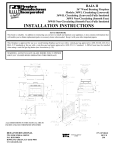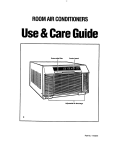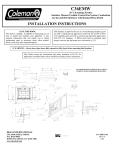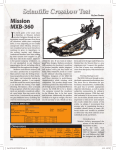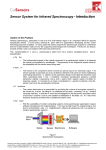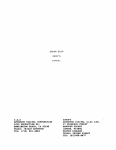Download Coleman 36ECMII Installation manual
Transcript
36ECMII 36” Circulating Louvered Firebox Includes: Manual Variable Control Fan System, Combustion Air Kit and Bi-Fold Doors with Brushed Brass finish INSTALLATION INSTRUCTIONS SAVE THIS BOOK This book is valuable. In addition to instructing you on how to install and maintain your appliance, it also contains information that will enable you to obtain replacement parts or optional accessory items when needed. Keep it with your other important papers. WARNING: ALWAYS LEAVE GLASS DOORS FULLY OPENED OR FULLY CLOSED WHEN OPERATING THIS FIREPLACE. This firebox meets the construction and safety standards of H.U.D. for application in mobile homes when installed according to these instructions. This fireplace is approved for use as a wood burning fireplace or for use with a vented gas log approved to ANS Z21.60, Z21.84 or RGA 2-72 standards or for use with a vent-free gas log heater approved to ANS Z21.11.2 standard. A vent-free log can only be installed in an aftermarket (completion of sale, not for purpose of resale from the manufacturer), permanently located, manufactured (mobile) home, where not prohibited by local codes. A DESA hood must be installed when using a vent-free gas log heater (see Accessories, p. 11) ALL DIMENSIONS IN THIS MANUAL ARE IN INCHES UNLESS OTHERWISE SPECIFIED DESA INTERNATIONAL 2701 INDUSTRIAL DRIVE P.O. BOX 90024 BOWLING GREEN, KY 42102-9004 www.desatech.com PN 54024 REV F 6/02 CONTENTS 1. INTRODUCTION --------------------------------------------------------------------------------- PG. 2 2. SELECTING LOCATION --------------------------------------------------------------------------------- PG. 2 3. MINIMUM CLEARANCES --------------------------------------------------------------------------------- PG. 2 4. FRAMING AND INSTALLING --------------------------------------------------------------------------------- PG. 3 5. HEARTH EXTENSION --------------------------------------------------------------------------------- PG. 3 6. OUTSIDE AIR KIT INSTALLATION --------------------------------------------------------------------------------- PG. 4 7. FAN KIT ASSEMBLY --------------------------------------------------------------------------------- PG. 4 8. CHIMNEY PIPE INSTALLATION --------------------------------------------------------------------------------- PG. 4,5,6 9. TERMINATIONS --------------------------------------------------------------------------------- PG. 6 10. FINISHING YOUR FIREPLACE --------------------------------------------------------------------------------- PG. 7 11. MANTELS --------------------------------------------------------------------------------- PG. 7 12. GLASS DOORS --------------------------------------------------------------------------------- PG. 7 13. GAS LINE INSTALLATIONS --------------------------------------------------------------------------------- PG. 8 14. CHIMNEY OFFSET --------------------------------------------------------------------------------- PG. 9 15. DAMPER OPERATION --------------------------------------------------------------------------------- PG. 10 16. TECHNICAL SERVICE --------------------------------------------------------------------------------- PG. 10 17. REPLACEMENT PARTS AND ACCESSORIES --------------------------------------------------------------------------------- PG. 11 1 • • • • WARNING: DO NOT INSTALL A FIREPLACE INSERT IN THIS BOX UNLESS THE MANUFACTURER’S INSTRUCTIONS WITH THE INSERT SPECIFICALLY STATE THIS FIREPLACE HAS BEEN TESTED FOR USE WITH THE INSERT. FOR YOUR SAFETY Do not store or use gasoline or any other flammable vapors or liquids in the vicinity of this or any other appliance. Due to high temperatures, the appliance should be located out of traffic and away from furniture and draperies. Do not place clothing or other flammable materials on or near the appliance. NEVER leave children unattended when a fire is burning in the fireplace. This fireplace is intended to be used as a decorative appliance and is not intended to be used to heat the home. This wood burning fireplace complies with the UL 127 standard as a FACTORY BUILT FIREPLACE and is listed and tested by Underwriters Laboratories Inc. CAUTION: The structural integrity of the mobile home floor, and ceiling/roof must be maintained. WARNING: IMPROPER INSTALLATION, ADJUSTMENT, ALTERATION, SERVICE OR MAINTENANCE CAN CAUSE INJURY, PROPERTY DAMAGE, OR LOSS OF LIFE. REFER TO THIS MANUAL FOR ASSISTANCE OR ADDITIONAL INFORMATION. CONSULT A QUALIFIED INSTALLER OR LOCAL DISTRIBUTOR. CHECK HUD REQUIREMENTS INSTALLING THIS FIREPLACE. SELECTING LOCATION To determine the safest and most efficient location for the fireplace, you must take into consideration the following guidelines: 1. The location must allow for proper clearances (see figures 1 & 2). 2. Consider a location where the heat output would not be affected by drafts, air conditioning ducts, windows or doors. 3. A location that avoids the cutting of joists or roof rafters will make installation easier. 4. An outside air kit is included with this fireplace. For more details refer to section on outside air kit installation on page 4. BEFORE INTRODUCTION Model 36ECMII is specifically designed for use in manufactured mobile homes. This fireplace includes a manual control fan system, combustion air kit and bi-fold doors with a brushed brass finish. WARNING: DO NOT INSTALL IN A BEDROOM. BEFORE YOU BEGIN ♦ Before beginning the installation of the fireplace, read these instructions through, completely. ♦ These DESA components and fireplace are safe when installed according to this Installation Manual. Unless you use DESA components, which has been designed and tested for the fireplace system, you may cause a fire hazard. ♦ The DESA warranty will be voided by and DESA disclaims any responsibility for the following actions: a) Modification of the fireplace, components, doors, blower, fans, air inlet system and damper control. b) Use of any component part not manufactured or approved by DESA in combination with a DESA fireplace system. MINIMUM CLEARANCES TO COMBUSTIBLES: • Back and sides of fireplace …………………..1/2” Min. Note: the ½” clearance is not required at the nailing flanges • Floor* ………………………….…………………0” Min. *See step 2 of “Installing the Fireplace” – next page • Wall to front of Fireplace ……………………….36” Min. • Perpendicular Wall to Opening of Unit ………...14” Min. • Top Spacers …………………..…………………..0” Min. • Mantel Clearances …………………………… see page 7 “Finishing your Fireplace” • Chimney Outer Pipe Surfaces ……………………1” Min. PROPER INSTALLATION is the most important step in ensuring safe and continuous operation of the fireplace. Consult the local building codes as to the particular requirements concerned with the installation of all factory built fireplaces. Although grounding may not be required by code the manufacturer recommends it. MINIMUM/MAXIMUM CHIMNEY HEIGHT: The MINIMUM height of the chimney, measured from the base of the fireplace to the flue gas outlet of the termination, is 11 feet for straight flue or a flue with one elbow set. The maximum distance between elbows is 2 feet. The maximum height of any system is 20 feet. This measurement includes the fireplace, chimney sections and the height of the termination assembly at the level of the flue gas outlet (see pg. 6, fig. 14). WARNING: DO NOT PACK REQUIRED AIR SPACES WITH INSULATION OR OTHER MATERIALS. This model fireplace 36ECMII meets the construction and safety standards of HUD for application in mobile homes when installed according to these instructions. 2 example, if the material selected has a K factor of 0.25, such as glass fiber, the following formula would apply. 0.25/0.84 x 1.0” = 0.30 thickness required. Thermal conductivity “K” of materials can be obtained from the manufacturer or supplier of the non-combustible material.] If the hearth extension is to be covered, use non-combustible material such as tile, slate, brick, concrete, metal, glass, marble, stone etc. Provide a means to prevent the hearth extension from shifting and seal the gap between the fireplace frame and hearth extension with a non-combustible material (see figure 3). FRAMING AND INSTALLING THE FIREPLACE STEP 1: Frame the opening for the fireplace using the dimensions shown in figure 1 or 2. STEP 2: If the fireplace is to be installed directly on carpeting, tile (other than ceramic), or any combustible material other than wood flooring; the fireplace must be installed upon a metal or wood panel extending the full width and depth of the fireplace. STEP 3: Position the fireplace as shown in figure 4a by sliding the unit backward until the nailing straps on each side touches the side framing. STEP 4: Check the level of the fireplace and shim with sheet metal if necessary. STEP 5: Before securing fireplace to prepared framing, the ember protector (provided), must be placed between the hearth extension (not supplied), and under the bottom front edge of the fireplace to protect against glowing embers falling through. If the fireplace is to be installed on a raised platform, a Z-type ember protector (not supplied) must be fabricated to fit your required platform height. The ember protector should extend under the fireplace a minimum of 1-½”. The ember protector should be made of galvanized sheet metal (28ga. minimum) to prevent corrosion. STEP 6: Secure fireplace to floor using tie-down straps (see figure 4) to prevent shifting. Figure 1 Figure 3 WARNING: HEARTH EXTENSION INSTALLED ONLY AS ILLUSTRATED. IS TO BE FRAMING DIMENSION Figure 4 Figure 2 CORNER INSTALLATION Figure 5 HEARTH EXTENSION: (HE 36) A hearth extension projecting a minimum of 16” in front of and a minimum of 8” beyond each side of the fireplace opening is required to protect combustible floor construction in front of the fireplace. Use DESA hearth extension (see accessories on page 11) HE 36 or an equal material which meets the following specifications: a layer of noncombustible, inorganic material having a thermal conductivity of K=0.84 BTU IN/FT. HR. F (or less) at 1” thick. [For OUTSIDE AIR KIT (MODEL AK6E) The installation of an outside air kit should be installed during the rough framing of the fireplace due to the nature of its location. Outside combustion air is accessed through the mobile home floor (Refer to AK-6 Installation Instructions for details). In some instances, a wall installation is required (see figure 5). Note: An AK6WE Air Kit must be ordered when a sidewall installation is required (see accessories on page 11). 3 FAN KIT ASSEMBLY (BK3) A fan kit assembly is preinstalled in this fireplace. Use of blowers or fans other than manufactured by DESA voids the warranty. The fan is operated by pressing the rocker switch located at the lower right hand corner of the fireplace face. Fan kit electrical connections are made through the electrical cover plate located on the side of the fireplace as shown in figure 6. Figure 8 There are three vent kits available, which have been specially designed for common installations in manufactured (mobile) homes: CPMH-A/AC (8’ Vent Kit), CPMH-A/ACA (9’ Vent Kit) and CPMH-A/ACB (9’ Vent Kit). The contents of these kits are listed under accessories on page 11. Most chimney systems for manufactured houses require a standard straight installation as described in this section. If an uncommon offset installation is required, see page 10. Figure 6 FAN KIT WIRING INSTRUCTIONS i. Loosen the strain relief by turning the plastic screw counterclockwise. ii. Remove electrical cover plate (with strain relief) from the fireplace by removing the two sheet metal screws as shown in figure 6. iii. Slide power source wiring through the strain relief opening and electrical cover plate and make all the necessary connections. iv. Slide all wiring connections in the electrical housing as shown in figure 7. v. Secure the electrical cover plate with screws previously removed. vi. Tighten strain relief plastic screw. NOTE: Electrical housing and cover plate have sharp edges, wear protective gloves. Important: If the height of the chimney assembly exceeds requirements for transportation of the home, the chimney installation may be completed after the home is sited. Note: the termination must always be installed after the home is sited. ASSEMBLING AND INSTALLING THE DOUBLE WALL CHIMNEY SYSTEM Each double wall chimney section consists of a galvanized outer pipe, a stainless steel inner flue pipe and a wire spacer. The pipe sections must be assembled independently as the chimney is installed. When starting chimney directly to the fireplace, the inner flue pipe section must be installed first with the lanced side up. The outer pipe section can then be installed over the flue pipe section with the hemmed end up. Press down on each pipe section until the lances securely engage the hem on the fireplace starter. The wire will assure the proper spacing between the inner and outer pipe sections. WARNING: THE OPENING IN THE COLLAR AROUND THE CHIMNEY AT THE TOP OF THE FIREPLACE MUST NOT BE OBSTRUCTED. NEVER USE BLOWN INSULATION TO FILL THE CHIMNEY ENCLOSURE. Continue to assemble chimney sections as outlined above, making sure that both the inner and outer pipe sections are locked together. When installing double wall “snap lock” chimney together, it is important to assure the joint between the chimney sections is locked. Check by pulling chimney upward after locking. The chimney will not come apart if properly locked. It is not necessary to add screws to keep the chimney together (Exception – see page 9 figure 23). Figure 7 CHIMNEY PIPE The DESA chimney system consists of 12, 18, 24, 36 and 48 inch, snap-lock double-wall pipe segments, planned for maximum adaptability to individual site requirements. Actual lengths gained after fitting overlaps must be taken into onsideration (lineal gain) and are given in the following chart: 4 If the adapter is needed, secure it onto the firestop using holes provided (see figure 10). The row of holes on the sides of the thimble is provided to allow for pitch variances. Position the firestop assembly and thimble to desired angle and secure with screws provided. Insert the thimble and firestop into the prepared opening and secure to the ceiling by nailing through the firestop flanges. The thimble should be even with or above the roofline. Thimble extensions are available (as an option) when required. See “accessories” on page 11. NOTE: If there is a second story in the home, firestop spacer 3600FS-8DM will be required. See “Firestop Spacer” on page 9. ADJUSTABLE FIRESTOP THIMBLE (FST-A): The Adjustable Firestop Thimble Assembly (FST-A) is used to provide the necessary air space and clearance between the chimney pipe and the insulation in the attic space of a manufactured home. To install the thimble assembly, determine the distance between the ceiling joist and the roof framing. Attach the adjustable thimble to the firestop spacer so that the assembly will cover the distance. The adjustable thimble should be even with or above the roofline (see thimble extensions on page 11 if a longer thimble is needed). Sheet metal screws or staples may be used to attach the thimble to the firestop spacer. An opening large enough to allow the insertion of the firestop thimble assembly will be required in the ceiling. Attach the firestop/thimble assembly to the ceiling/ceiling joists using screws or staples as shown in figure 9a. A minimum of 8 screws or staples should be used. Figure 9a PENETRATING THE ROOF: To maintain a 1-inch clearance to the pipe on a roof with a pitch, a rectangular opening must be cut. STEP 1: Determine the center point through which the pipe will penetrate the roof. STEP 2: Determine the center point of the roof. Pitch is the distance the floor drops over a given span, usually 12 inches. A 6/12 pitch means that the roof drops 6 inches for each 12 inches measured horizontally down the roof. STEP 3: Use the roof-opening chart (figure 11) below to determine the correct opening length and flashing required. STEP 4: Remove the shingles around the opening measured and cut out this section. STEP 5: Add the next sections of the pipe until the end penetrates the roofline. Check to see that the proper clearances are maintained. Extend chimney by adding sections of double wall pipe until pipe is a minimum of 30 inches above the highest point of the roof cutout. Termination and chimney must extend a minimum of 36 inches above the highest point where it passes through roof. Figure 9b The firestop thimble assembly should also be used where there is a cathedral ceiling, insulation barrier and roof, all in one assembly in a manufactured home (see figures 9b & 10). The FST-A Thimble can be used in any one of three common ceiling pitches; flat, 12”/96”, and 30”/144”. An opening big enough to allow the insertion of the firestop thimble assembly will be required. This opening depends on the pitch of your ceiling. If your ceiling is a flat or 12”/96” pitch, you must use the adapter plate provided to seal unwanted openings since the opening in the firestop is an ellipse. For 30”/144” pitch, discard the adapter. PITCH FLAT 0 - 6/12 6/12 - 12/12 SLOPE (degrees) 0 26.6 45.0 OPENING "A" MAX (inches) 15 16 - 1/8 20 - 3/8 USE FLASHING MODEL NO. 6F-8 6F-8 12F-8 Figure 11 IMPORTANT: If an exposed portion of chimney is greater than four feet above the roofline, use support wires to keep the chimney secured. The support wires may be attached to the outer pipe of the chimney with screws provided the screws do not penetrate the inner flue pipe. Figure 10 5 IMPORTANT: Terminations are required but can be installed once the manufactured house is sited. FLASHING INSTALLATION: (V6F-8DM or V12F-8DM) Determine the flashing to be used with the roof-opening chart. Slide flashing over pipe until base is flat against roof. Replace as many shingles as needed to cover exposed area and flashing base. Secure in position by nailing through shingles (see figure 12). DO NOT NAIL THROUGH FLASHING CONE. Figure 14 Figure 12 CAUTION: DO NOT SEAL OPENINGS ON THE ROOFTOP FLASHING. FOLLOW THE INSTALLATION INSTRUCTIONS PROVIDED WITH THE TERMINATION BEING USED. Terminations with 16” slip pipe sections are available. The RTT-8DM and RTTL-8DM are approved for flashing installations. When needed, these adjustable terminations may be used in combination with the pipe assembly to achieve the correct chimney height. NOTE: In the rare instance there is a problem with side driven rain or wind or the chimney is not drafting properly, an ADS8DM Anti Draft Shield can be used with round terminations. CHASE INSTALLATIONS: Instructions for chase installations are included with the chase style termination chosen. In a multiple chase installation, be sure to provide adequate distance between terminations to prevent smoke spillage from one termination to another. We suggest that terminations be separated at least 24 inches, center to center, and stacked at vertical height difference of 18 inches (see figure 15). INSTALLING FLASHING ON A METAL ROOF: When installing the flashing on a metal roof it is required that putty tape be used between the flashing and the roof. The flashing must be secured to the roof using #8 x ¾” screws and then sealed with roof coating to prevent leakage through the screw holes. A roof coating must also be applied around the perimeter of the flashing to provide a proper seal. STORM COLLAR INSTALLATION: (SC1 or SC2) Place storm collar over pipe and slide down until it is snug against the open edge of the flashing (see figure 13). Use SC1 for all round terminations and SC2 for all terminations with slip sections. Figure 13 Note: Storm collar is required but can be installed after the home is sited. TERMINATIONS / SPARK ARRESTOR: The fireplace system must be terminated with the listed round top terminations. In any case, refer to the installation instructions supplied with the termination. The terminations approved for this fireplace are the RT-8DM and RTL-8DM. Figure 14 shows an RTL-8DM round top termination. Figure 15 6 10 FOOT RULE: All flue gas outlet of chimney termination must extend a minimum of 3 feet in height above the highest point where it passes through the roof and must be at least 2 feet above the highest point of the roof that is within a horizontal distance of 10 feet (see figure 16). OPERATING GUIDELINES AND MAINTENANCE INSTRUCTIONS GLASS DOORS Glass doors are standard with the 36ECMII fireplace. When the fireplace is in operation doors must be in the FULLY OPEN or FULLY CLOSED position only or a fire hazard may be created (see figure 18). A fireplace equipped with glass doors operates much differently than a fireplace with an open front. A fireplace with glass doors has a limited amount of air for combustion. Excessive heat within the fireplace can result if too large a fire is built or if the combustion air gate is not completely open. The following tips should be followed to assure that both the fireplace and the glass door retain their beauty and function properly. Both flue damper and the glass doors must be fully open before starting the fire. This will provide sufficient combustion air and maintain safe temperatures in the firebox. Figure 16 FINISHING THE FIREPLACE: Combustible materials, such as wallboard, gypsum board, sheet rock, drywall, plywood, etc may make direct contact with sides and top periphery of the fireplace face. It is important that combustible materials do not overlap the face itself. Brick, glass, tile or other non-combustible materials may overlap the front face provided they do not obstruct essential openings like louvered slots or any other opening. When overlapping with a non-combustible facing material use only non-combustible mortar or adhesive. MANTELS: A mantel may be installed if desired (see figure 17). Woodwork such as wood trims, mantels, or any other combustible material projecting from the front face must not be placed within 9 inches of the fireplace opening (and within 6 inches of the top louver opening). Combustible materials above 9 inches and projecting more than 1-1/2 inches from the fireplace face must not be placed less than 12 inches from the top of the opening of the fireplace (NFPA STD 211, Sec. 73.3.3). Figure 18 IMPORTANT: The glass must be allowed to warm slowly and evenly. The tempered glass will withstand a gradual temperature rise to 550 degrees Fahrenheit, which is more than a normal fire will generate. Such materials as pitch/waxladen logs, very dry mill end lumber, and large amounts of paper or cardboard boxes can create an excessively hot fire and should not be burned in this fireplace. Always keep the fire well back from the doors and never allow flames to contact the glass. WARNING: FIREPLACES EQUIPPED WITH GLASS DOORS SHOULD BE OPERATED ONLY WITH DOORS FULLY OPEN OR DOORS FULLY CLOSED. DOORS, IF LEFT PARTLY OPEN, MAY DRAW GAS AND FLAME OUT OF THE FIREPLACE OPENING CREATING RISKS OF BOTH FIRE AND SMOKE. Figure 17 CLEANING THE GLASS: Clean the glass with any commercial glass cleaner or soap and water. DO NOT use any abrasive material to clean the glass. DO NOT clean the glass with any cool water if the glass is still hot from the fire. MINIMUM FRONT AND TOP CLEARANCES NOTE: HUD requirements may supersede these minimum dimensions. 7 A vent-free log may be installed in an aftermarket,* permanently located, manufactured (mobile) home, where not prohibited by local codes. *Aftermarket: Completion of sale, not for purpose of resale, from the manufacturer. FOR PERMANENTLY LOCATED (SITED) HOMES ONLY: OPTIONAL GAS LINE INSTALLATION GAS LINE HOOK UP SHOULD BE DONE BY YOUR SUPPLIER OR A QUALIFIED SERVICE PERSON. NOTE: BEFORE YOU PROCEED, MAKE SURE YOUR GAS SUPPLY IS TURNED OFF. A gas line may be installed for the purpose of installing a vented or vent-free gas appliance available through your local distributor. Use only a ½ - inch black iron pipe and appropriate fittings. When installing a gas line, a shut-off valve designed for installation outside the appliance is recommended. STEP 1: To install, remove the knockout indentation on the refractory, (or firebrick), wall located approximately 2 inches above the refractory hearth floor. The knockout indentation must be firmly tapped with any solid object until it is released. Remove fragmented portions of refractory (see figure 19). Figure 19 STEP 2: Remove gas line cover plate on rear of fireplace and pull out insulation from gas line conduit sleeve. Save insulation for reuse. STEP 3: Run a ½ inch black iron gas line into the fireplace through the gas line conduit sleeve (if using a raised platform, add height). Provide sufficient gas line into fireplace chamber for fitting connection (see figure 20). Figure 20 STEP 4: Repack insulation around gas line and into sleeve opening. Seal any gaps between gas line and refractory knockout hole with refractory cement or commercial furnace cement. Install the gas appliance or cap-off gas line if desired. NOTE: A DESA hood must be installed when using an unvented gas log set (see accessories on page 11). WARNING: DO NOT OPERATE AN UNVENTED GAS LOG SET IN THIS FIREPLACE WITH THE CHIMNEY REMOVED. CAUTION: All gas piping and connections must be tested for leaks after the installation is completed. After ensuring that the gas valve is on, apply a commercial leak detection solution to all connections and joints. Bubbles forming show a leak. Correct all leaks at once. DO NOT USE AN OPEN FLAME FOR LEAK TESTING AND DO NOT OPERATE ANY APPLIANCE IF A LEAK IS DETECTED. LEAK TESTING SHOULD BE DONE BY A QUALIFIED SERVICE PERSON. If you install a decorative gas appliance (vented gas log), the decorative gas appliance must comply with the Standard for Decorative Gas Appliances for Installation in solid fuel burning Fireplaces, ANS Z21.60-1996, Z21.84 or RGA 2-72, and shall also be installed in accordance with the National Fuel Gas code, ANS Z223.1-1996. WARNING: If the fireplace has been used for wood burning, the firebox and chimney must be cleaned of soot, creosote and ashes by a qualified chimney cleaner. Creosote will ignite if highly heated. NOTE: Secure incoming gas line to wood framing to provide rigidity for threaded end. If you wish to install an unvented (vent-free) gas log set, ONLY UNVENTED GAS LOG SETS WHICH HAVE BEEN FOUND TO COMPLY WITH THE STANDARD FOR UNVENTED ROOM HEATERS, ANSI Z21.11.2, ARE TO BE INSTALLED IN THIS FIREPLACE. WARNING: WHEN USING A DECORATIVE VENTED GAS LOG, THE DAMPER MUST BE REMOVED OR PERMANENTLY LOCKED IN THE FULLY OPENED POSITION. 8 FIRESTOP SPACERS: (3600FS-8DM) 3. Firestop spacers are required at each point where the chimney penetrates a floor space. Their purpose is to establish and maintain the required clearance between the chimney and the combustible materials. When the pipe passes through a framed opening into a living space above, the firestop must be placed onto the ceiling from below as shown in figure 21. Figure 22 Figure 21 INSTRUCTIONS WHEN ELBOW OFFSET OF CHIMNEY IS NEEDED: (30E-8DM) TO INSTALL ELBOWS 1. To achieve desired offset, you may install combinations of 12”, 18”, 24”, 36” and 48” length of double wall pipe (SEE SINGLE OFFSET CHART, FIGURE 22 & 24). All joints between offset should be secured with two screws, only on the outer pipe, and shall not penetrate the inner stainless. SINGLE OFFSET CHART OFFSET A 4 - 3/8 9 - 3/4 12 - 3/4 15 18 21 - 1/4 23 - 3/4 27 - 3/4 30 33 36 38 - 1/4 41 - 1/4 45 46 - 3/4 51 53 - 1/4 56 - 1/4 59 - 1/4 61 - 3/4 64 - 3/4 68 - 1/4 70 74 - 1/4 76 - 3/4 79 - 3/4 2. Maximum length of pipe between supports (return elbow or 12S-8DM) is 6’ of angled run. Maximum of two (2) 6’ angled run sections per chimney system (see figure 24). RISE B 16 -3/8 25 - 1/2 30 - 3/4 34 - 3/4 40 46 - 1/4 49 - 1/4 56 - 3/4 60 - 3/4 66 71 75 80 - 1/4 86 - 3/4 89 - 1/2 97 101 106 - 1/4 111 - 1/2 115 - 1/2 120 - 3/4 127 130 137 - 1/2 141 - 1/2 146 - 3/4 CHIMNEY LENGTH 48" 36" 24" 18" ELBOW SET ONLY 12" 1 1 1 1 Figure 23 1 1 1 1 1 1 1 1 1 1 2 1 2 1 1 2 1 2 2 1 2 1 1 1 1 1 1 1 1 2 1 1 1 1 1 2 1 2 2 4 1 1 1 Figure 24 Chimney weight above offset rests on return elbow. Straps must be securely nailed to rafters or joists (see figure 22, details a & b). *TYPICAL OFFSET INSTALLATION *For systems with 2 elbow sets, the maximum height 20 ft. 9 FIREPLACE FACE EXTENSION: (FE-36) A fireplace face extension is available for use with this fireplace as an optional part. To install, secure the fireplace face extension to the top of the fireplace face with four self-drilling screws (provided) as shown in figure 25. Figure 26 WARNING: Risk of fire! Replace grate with DESA model 36 GR grate only. This grate has been designed to keep the operation of your fireplace safe and efficient. FOR FURTHER OPERATING GUIDELINES, INSTRUCTIONS AND WARRANTY INFORMATION PLEASE REFER TO YOUR HOMEOWNERS GUIDE OR CONTACT YOUR AUTHORIZED DEALER. Figure 25 DAMPER OPERATION: The damper handle to open and close the damper blade is located inside the firebox at the center towards the back wall. Pushing the handle back in the keyway slot will free the damper blade to automatically open. To close, reach in and push the handle back into the keyhole slot then pull down and forward to lock it in place (see figure 26). TECHNICAL SERVICE You may have further questions about installation, operations, or troubleshooting. If so, contact The Technical Service Department at 1-888-427-8322. When calling, have the model number of the fireplace ready. 10 REPLACEMENT PARTS ACCESSORY PARTS VENT KIT PART NUMBERS SEE BELOW VENT KITS - USE FOR MOST COMMON MANUFACTURED (MOBILE) HOME INSTALLATIONS CONTENTS CPMH-A/AC CPMH-ACA CPMH-A/ACB 36-8DM 36" Double Wall Pipe 2 1 2 24-8DM 24" Double Wall Pipe 1 3 0 18-8DM 18" Double Wall Pipe 0 0 2 FST-A Adjustable Firestop Thimble 1 1 1 6F-8 Roof Flashing 1 1 1 VSC1-8DM Storm Collar 1 1 1 RTL-8DM Round Cap Termination 1 1 1 8' vent kit 11 9' vent kit 9' vent kit P/N 035-16689-000













